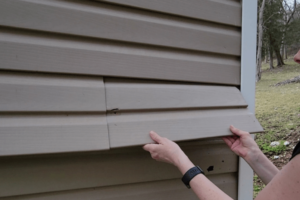The Advantages of Vinyl Siding
Homeowners can get a high return on investment from vinyl siding, which is one of the least expensive exterior cladding options. It also requires the least amount of maintenance, including a quick rinse with a hose once or twice a year.
Unlike wood, vinyl doesn’t require staining, painting, or caulking. It’s also energy-efficient and durable enough to last decades. Click https://sidingrepaircharleston.com/ to learn more.
Vinyl siding is an affordable and practical way to transform a home’s exterior. It comes in a variety of colors and textures, allowing homeowners to customize their ideal exterior design. It’s also quick to install, meaning homeowners can enjoy a new look in less than a week. However, it’s important to keep in mind that the cost of installing vinyl siding will depend on a variety of factors, including the type of house and the contractor. Skywalker Roofing experts recommend budgeting an additional 10% to 20% for any unforeseen expenses that may arise during the installation process.
The price of vinyl siding will vary depending on the manufacturer and style. The more popular brands tend to be more expensive, but they offer superior quality and durability. They also come with a warranty, so homeowners can be confident that they are getting their money’s worth.
One of the biggest cost considerations when deciding on vinyl siding is labor. Many professionals charge an hourly rate, which can quickly add up if the project takes longer than expected. Similarly, the cost of hiring equipment and materials can increase the total bill. Lastly, homeowners should factor in any HOA requirements or other factors that could increase the project’s time and cost.
Another important aspect of the cost of vinyl siding is the cost of removing any existing materials. This can be a costly part of the project, especially if the original material is rotting or damaged. To reduce these costs, homeowners can try to salvage as much of the old material as possible.
Vinyl is a durable product that can stand up to harsh weather conditions. It’s a great alternative to more expensive, traditional options like stucco and wood. It also offers a number of benefits, such as fade-resistant finishes and scratch-resistant surfaces. It’s easy to see why this is such a popular choice among homeowners.
When choosing vinyl, it’s important to find a trusted professional who will do the job right. It’s also a good idea to budget extra time and money for unforeseen issues that may occur during the installation process. It’s also a good idea not to overbuy building supplies, as this can lead to waste. Instead, purchase only what you know you will need. This will save you money in the long run, and ensure that all the necessary materials are available for your project.
Styles
There are many different styles of vinyl siding available on the market today. Some of them offer a classic wood look, while others provide an upscale or traditional style for your home. You can also get a variety of color options. Choosing the right color for your house will affect how people think about your home and the way they interact with it.
A vinyl siding company can help you choose the best colors for your home. They can provide you with a variety of tools that can help you find the perfect shade for your house, including a color wheel and online visualizers. They can also help you choose a color that will complement your roof and other outdoor features.
Most vinyl siding has its own locking system and is nailed to the wall using nails that are loosened to allow for expansion and contraction of the product. The bottom lock of the vinyl locks into a starter piece or onto the top lock of the panel below it. The loosening of the nails allows for a little “float” that can help compensate for the varying temperatures and weather conditions over time.
One of the most important factors to consider when choosing a vinyl siding color is the effect it will have on the overall image of your home. Siding colors can make a difference in how people perceive your home, and they can also impact their thoughts about you and your family. For example, blue shades tend to elicit a feeling of calm and relaxation, while bright yellow can make your home appear larger.
When you choose a vinyl siding color, it is important to take the time to research the available options. It is also a good idea to consult with an experienced siding contractor to ensure you are making the best decision.
Unlike other siding materials, vinyl is made to withstand harsh outside elements. It can withstand heat, strong winds, rain, and hail. In addition, it is less likely to rot or rust than metal and other types of cladding.
Installation
Before you begin your vinyl siding installation project, take the time to acquire any necessary building permits. This will ensure that your project meets all local standards and regulations, and it will also give you peace of mind throughout the process. Additionally, you may want to consider hiring a professional siding company to handle the job. They have the expertise, multi-person teams, and tools to ensure a flawless result.
When replacing vinyl siding, make sure that the new panels match the color and style of your existing home. This will enhance your curb appeal and help your property retain value. In addition, a new coat of paint will cover any mildew or mold that has developed. It is also important to replace any panels that have been damaged by weather or by animals. These minor issues can lead to moisture and other problems within your home if left unchecked.
Once your new vinyl siding is installed, be sure to keep up with regular maintenance. This includes cleaning the surface using a mild detergent and removing any organic debris from your exterior walls. This will help prevent mildew and mold from developing, and it will also help your vinyl siding last longer.
If you notice any issues with your vinyl siding, be sure to call a professional to repair it as soon as possible. Damaged siding can lead to moisture, insects, and other problems that can damage your home and lower its resale value. Moreover, the appearance of a damaged house can be a turnoff to potential buyers.
Vinyl siding is usually installed over wood sheathing such as plywood or oriented strand board (OSB). It can also be installed over foam plastic insulating sheathing. When installing vinyl siding over these materials, the fasteners must penetrate at least 14 inch through the sheathing and the wall.
When hammering the nails that hold the vinyl to the wall, don’t nail them in too tightly. This can cause the panels to buckle or crack as they expand and contract with different weather conditions. Always hammer the nails into the center of their provided nailing slots, and leave a small gap between the nail and the vinyl (the width of a dime is ideal). Also, when it comes to the corners, be careful not to bury the fasteners too deep. This can encourage mice and other pests to crawl inside the vinyl corner posts.
Maintenance
A wide variety of styles, textures and colors makes vinyl siding a desirable choice for homeowners. It’s also relatively easy to install and less expensive than other cladding options. Despite these advantages, maintenance is necessary to keep your home’s exterior looking great.
A routine inspection of your home’s exterior is the best way to catch any damage or repairs early. Many factors can dull the appearance of your home’s vinyl siding, including dirt, pollen, bird poop, mildew and traffic fumes. These pollutants can be removed with a general household cleanser, but more serious stains may require professional cleaning or replacement.
In addition to regularly inspecting your home’s exterior, you should wash the vinyl siding once or twice a year. During these cleanings, you should use a power washer or soft bristled brush to remove dirt and grime. It’s important to note that vinyl isn’t designed to withstand high-pressure water pressure, so be careful not to use excessive force or you could crack or damage the surface.
The good news is that unlike wood paneling, vinyl is resistant to rot and other structural damage caused by termites or other pests. This means you can save on costly maintenance and repair costs by choosing this type of cladding for your home.
Although vinyl is durable and can withstand most weather conditions, it can crack due to temperature fluctuations. This problem is especially noticeable in colder climates. It’s crucial to have any cracked or damaged panels replaced as soon as possible to avoid further damage and rotting of the structure.
Repairing or replacing vinyl is a simple and affordable project that most experienced or beginner DIYers can handle. Using caulk or patching material, you can fill in holes or cracks in the vinyl. It’s important to select a matching color so that the repair isn’t noticeable. If you can’t find a match, you can paint the new piece of vinyl with acrylic house paint to hide any signs of wear and tear.
If your home’s vinyl is damaged by severe weather or by another event, you may be able to file an insurance claim. Our team can help you navigate the process to ensure that you receive the compensation you need to replace your damaged vinyl with a quality product.
